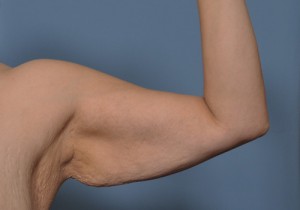
Why this dramatic increase in arm lift surgery? There are a variety of reasons which include new technologies and techniques to treat heavy and bigger upper arms as well as a societal trend towards more shapely upper arms. But a major factor has been the concomitant number of people who have undergo large amounts of weight loss as a result of bariatric surgery and other weight loss methods. The flappy arms that result from extreme weight loss can not be treated by any other method than surgery and the arms are always on the top three concerns of these patients.
The influence of weight loss on the rise of arm lifts is reflected in the over 6,000 arm lifts that were performed specifically after masssive weight loss, representing 42% of all arm lifts done in 2012. The elasticity of arm skin between men and women is known to be different as very few men ever get armlifts. Despite men who undergo large amounts of weight loss, they very rarely end up with flappy arms or ‘bat wings’. It is so uncommon that I in my Indianapolis plastic surgery practice have never even seen a weight loss male complain about their upper arms. This is corroborated by the scant few male arm lifts reports with just over 300 done, representing a meager 0.02% of all armlifts done. The typical armlift patients is a female between the ages of 40 and 54.
Since nearly 60% of arm lifts are done in non-weight loss patients, it is clear that there is a strong societal and fashion influence as well. While the female who is working out and getting their body toned may not be getting their desired result in their arms, the historic concept of a surgical armlift and its scar is not a worthwhile trade-off. The aesthetic standards of most more normal weight females is obviously quite different from that of the massive weight loss patient. And while improved suturing/wound closure techniques and scar treatments are available, it is just not a problem that most women want to acquire.
But the full or thick upper armed woman in the past who was not a good candidate for an armlift (brachioplasty) may now consider a variety of liposuction treatment methods. Upper arm fat can be removed using traditional, laser-assisted (Smartlipo) or power-assisted liposuction, to name a few, or even some non-surgical methods such as Cool Sculpting or Exilis. While none of these options will ever work as well as an armlift, they all avoid the need to end up with a long scar. And for the more normal weight female, some arm shape improvement is better even if it is not a dramatic circumferential reduction.
The coalescing of better methods of fat removal and the ability to create some degree of skin tightening, all with no to minimal scarring, has been a major impetus for the exponential increase in arm reshaping procedures. The concept of arm lifts today no longer always mean that it requires a scar to achieve it.
Dr. Barry Eppley
Indianapolis, Indiana


